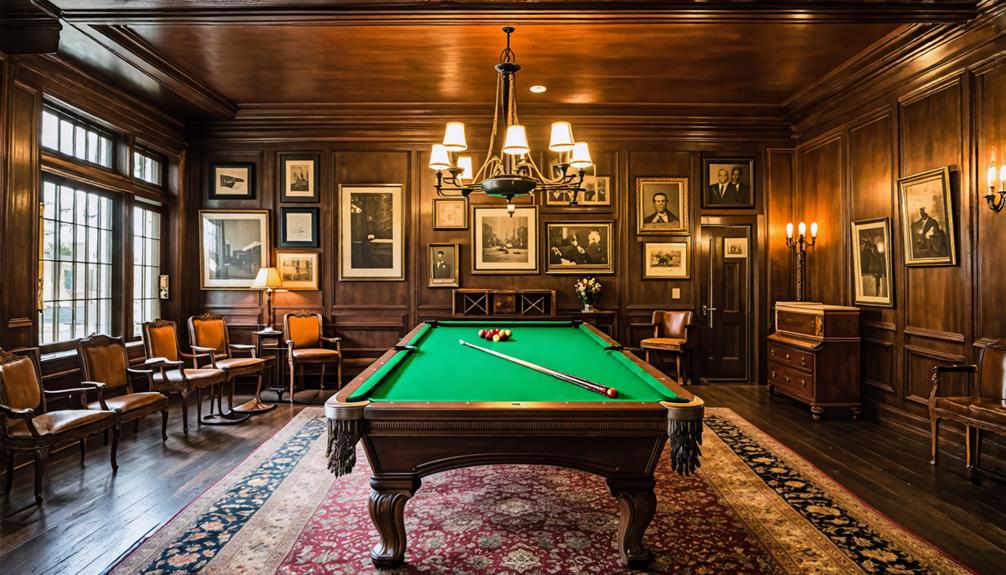The History of Foosball: From Origins to Modern Day
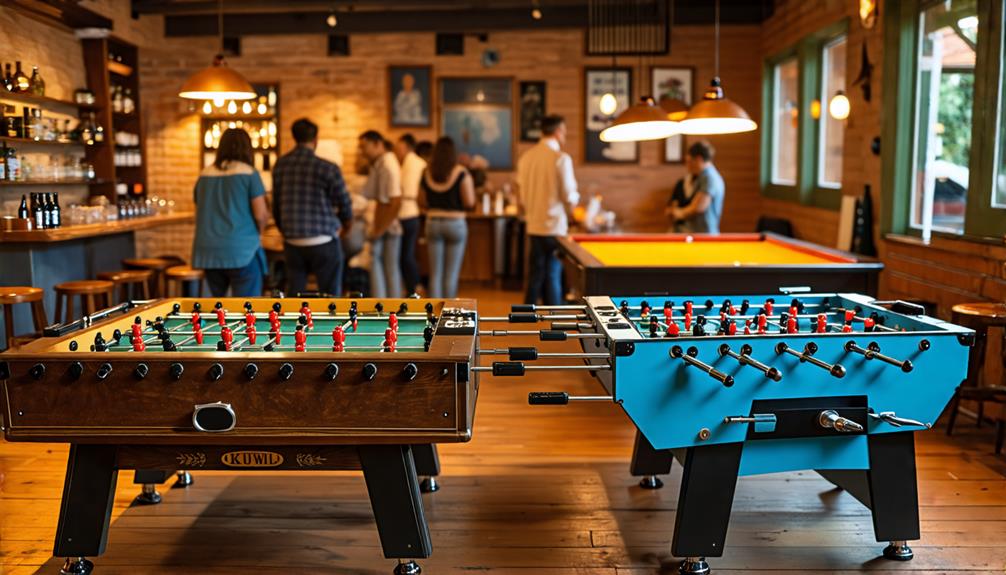
Foosball's journey began in the early 1920s, evolving from a simple marble game into the dynamic sport we know today. Its rise in popularity during the 1960s and 70s in the U.S. marked significant moments in its competitive play and cultural impact. However, challenges emerged that threatened its survival, making it essential to understand these pivotal events to appreciate foosball's current status.
Origins of Foosball
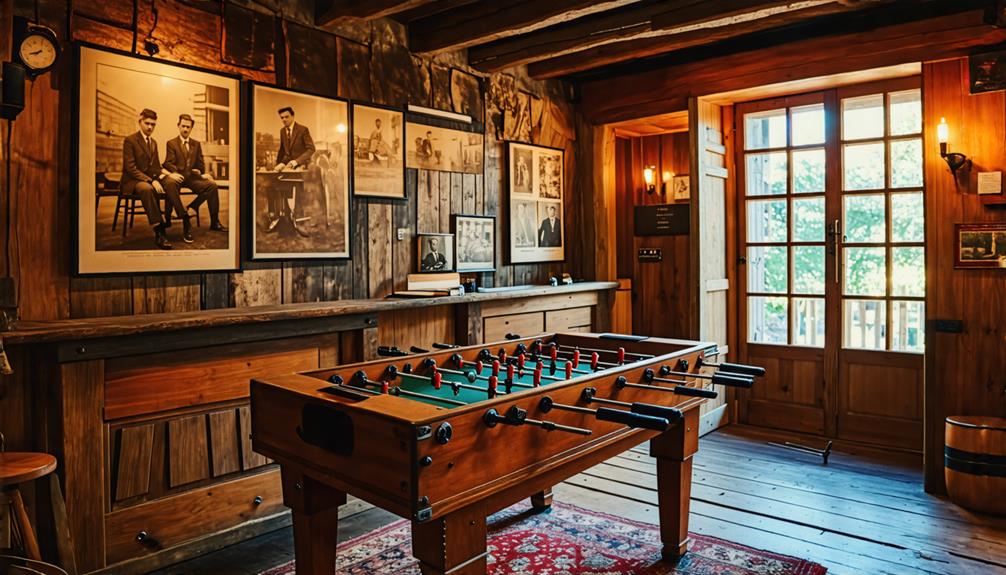
Foosball, a tabletop version of soccer, was invented by Harold Thornton in the early 1920s to bring the excitement of the sport into people's homes. Inspired by the German term 'fussball,' meaning soccer, Thornton designed an engaging indoor activity. His initial concept featured a box-like table with holes for marbles, but it eventually evolved into the modern foosball table, complete with rods and player figures. The history of foosball also includes contributions from other inventors like Lucien Rosengart and Alexandre de Finesterre, who developed similar games in the late 19th and early 20th centuries.
Lawrence Patterson played a pivotal role in popularizing foosball in the United States. In 1962, he introduced one of the first wooden foosball tables, making the game accessible to a wider audience. This helped establish foosball as a popular pastime in American culture, enjoyed by players of all ages. The origins of foosball reflect a blend of creativity and a passion for soccer, ensuring its enduring popularity.
Evolution of the Game
As you explore the evolution of foosball, you'll observe how historical inventions and patents established the foundation for the game we know today. The transition to competitive play brought the sport into the limelight, attracting both players and fans. This shift not only refined the rules but also paved the way for high-stakes tournaments that now define modern foosball.
Historical Inventions and Patents
The evolution of table soccer, commonly known as foosball, is marked by several key inventions and patents that have significantly shaped the modern game. A pivotal moment occurred when Harold Searles Thornton received the primary patent for a foosball-like game in the UK on November 1, 1923, officially recognizing table soccer as a distinct game. Prior to this, variations were being played across Europe, with notable patents filed in Germany and France during the late 19th century.
Three major contributions that influenced the development of foosball are:
- Lucien Rosengart's 'Baby Foot' - Developed in the late 1930s, this version was specifically intended for children, highlighting the game's versatility.
- Alexandre de Finesterre's Design - During the Spanish Civil War in 1937, while recovering in a hospital, he proposed an innovative foosball table design that significantly advanced the game's development.
- Coin-Operated Tables - Introduced in the 1960s, these tables boosted the game's popularity in the United States, making it a common feature in arcades and bars.
These inventions and patents were instrumental in the evolution and widespread adoption of foosball.
Transition to Competitive Play
Competitive play in foosball gained significant traction in the mid-20th century, transitioning from a casual pastime to a structured sport. The establishment of the first foosball league in Belgium in 1950 marked the start of organized competitive play. The 1975 launch of the premier US professional table soccer tour further solidified the sport's status, leading to the creation of the United States Table Soccer Association (USTSA) in 1985.
By the early 2000s, the formation of the International Table Soccer Federation (ITSF) introduced standardized rules and organized international competitions, elevating foosball tournaments globally. Major events like the International Tournament Soccer Championships reached their peak in the late 1970s, offering substantial cash prizes and highlighting the competitive nature of the sport.
Different styles of play, such as American/Texas, European/French, and German, have enriched the competitive landscape. The evolution of foosball tables and the rise of skilled players have made the game more thrilling and accessible, solidifying its place as a respected sport in the competitive arena.
Cultural Impact in the U.S

Foosball became a cultural phenomenon in the U.S. during the 1970s, captivating audiences and players alike with its vibrant tournament scene and widespread media coverage. The growing popularity of foosball was evident in several ways:
- The International Tournament Soccer Championships peaked in 1978, featuring a staggering $1 million prize.
- Major media outlets, including Sports Illustrated and 60 Minutes, highlighted foosball, bringing it into households across the nation.
- American players embraced foosball as a social pastime, frequently gathering at local arcades to compete and enjoy the game.
Although the rise of video games in the 1980s led to a slight decline in interest, foosball maintained its relevance. Its status as an arcade game ensured it held a place in American culture, attracting new generations of players. The late 1980s also saw foosball shift into franchise sales, further solidifying its appeal. Today, active communities and tournaments continue to engage players and spectators, showcasing the enduring charm of foosball. This unique blend of competition and social interaction keeps the spirit of foosball alive across the country.
Rise of Competitive Foosball
Exploring the rise of competitive foosball, it's evident that the International Table Soccer Federation (ITSF) has played a crucial role in organizing the sport. Major tournaments not only highlight the game's excitement but also showcase the significant skill development of players. Attracting top talent and offering substantial prizes, competitive foosball has firmly secured its place on the global stage.
Formation of ITSF
In 2002, the establishment of the International Table Soccer Federation (ITSF) marked a pivotal moment in the rise of organized foosball, unifying the sport under standardized rules and regulations. This move not only elevated the game's profile but also fostered a competitive spirit among players worldwide. With ITSF in place, players now compete in structured formats, leading to significant international tournaments.
Three key developments emerged from the formation of ITSF:
- World Championships: The ITSF organized the World Championships, bringing together top talent from across the globe to compete at the highest level.
- Approved Professional Tables: ITSF recognized specific professional tables, such as the Tornado Tournament 3000, ensuring consistent play conditions in competitions.
- Standardization of Rules: The ITSF implemented standardized rules across all international events, promoting fair play and clarity.
Thanks to ITSF's efforts, foosball gained increased recognition on an international level. The establishment of this governing body paved the way for a more organized approach to competitive play, ensuring that foosball continues to grow as a respected sport enjoyed by enthusiasts worldwide.
Major Tournament Highlights
Competitive foosball has seen a remarkable rise in popularity since the 1970s, with major tournaments showcasing top talent and offering substantial prizes. The U.S. professional table soccer tour, launched in 1975, marked the beginning of organized competitive foosball events. By 1978, the International Tournament Soccer Championships featured a groundbreaking $1 million prize, capturing widespread attention.
The establishment of the International Table Soccer Federation (ITSF) in 2002 further elevated the sport by standardizing rules and promoting international competitions. Today, high-caliber tournaments are primarily held in Europe, particularly in Germany and Italy, attracting top players from around the world. These events not only highlight competitors' skill and determination but also offer significant prize money.
Among these prestigious competitions, the Punta Umbría World Table Football Cup Championship in Spain stands out as a notable annual event. Here, players compete on five different table styles, emphasizing the diversity and competitiveness of foosball. As the scene continues to grow, competitive foosball is more exciting and accessible than ever.
Player Skills Evolution
The evolution of player skills in foosball reflects a blend of strategy, precision, and heightened competition, compelling participants to master advanced techniques and adapt to varied playing styles. Since the establishment of the International Table Soccer Federation (ITSF) in 2002, competitive foosball has transformed dramatically, emphasizing the need for elite skills.
Key Elements Driving This Evolution:
- Advanced Strategies: Top players meticulously analyze their opponents, employing tactics that exploit their weaknesses.
- Precision Execution: High-caliber tournaments demand players execute moves with pinpoint accuracy, achieving ball speeds of up to 35 mph.
- Adaptability to Varied Playing Styles: Different international tournaments feature unique table designs, requiring players to adapt and expand their skillsets for success.
Elite players like Jean-Louis Dupont and Mike Lambert exemplify this evolution, showcasing sharp reflexes and strategic gameplay that distinguish them from casual players. As competitive foosball continues to grow, the complexity of player skills will only deepen, pushing aspiring competitors to refine their techniques and strategies in pursuit of victory.
Notable Foosball Players
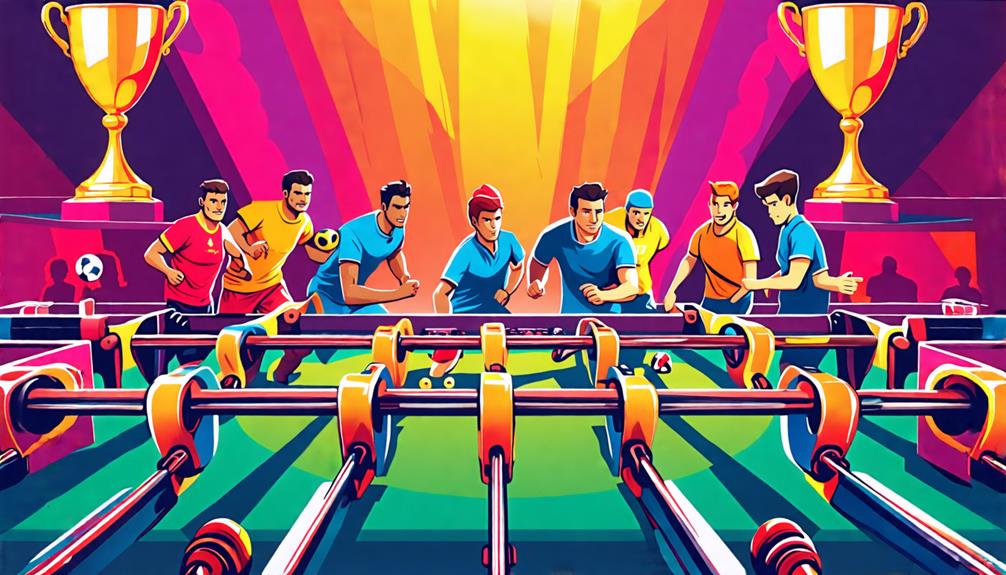
Among the elite in foosball, players like Jean-Louis Dupont and Mike Lambert have distinguished themselves with numerous championship titles. Their success in the sport underscores the importance of not only skills but also a strategic mindset. These notable players meticulously analyze their opponents, enabling them to maintain an edge during high-stakes matches.
In competitive play, sharp reflexes and quick decision-making are critical. Dupont and Lambert, along with other distinguished players like Dave Trease and Ruth Eastwood, exemplify these qualities through their exceptional performances. Trease is renowned for his unique brush shot technique, while Eastwood has earned recognition by ranking fourth nationally after winning a women's event.
The dedication of these top players sets them apart from casual participants. They invest countless hours in training, mastering advanced strategies, and honing their skills. Their commitment to excellence in the sport paves the way for evolving techniques and inspires future generations of foosball enthusiasts.
Major Foosball Tournaments
When considering major foosball tournaments, it's essential to understand the various formats and events that define the competitive landscape. Key championship events like the Multi-Table World Championships highlight the scene, alongside the influence of prize money trends on player participation. Let's explore these elements to provide a comprehensive view of the tournament landscape.
Tournament Formats Explained
Major foosball tournaments often use a double-elimination format, allowing players to recover and continue competing even after a loss. This structure maintains a high level of excitement and engagement, giving players ample opportunities to demonstrate their skills under pressure. The International Table Soccer Federation (ITSF) oversees these tournaments, ensuring consistent and fair rules across all participating countries.
In these tournaments, you can expect:
- Multiple Matches: Players engage in a series of matches where a single loss doesn't eliminate them; they've the chance to climb back to the top.
- ITSF-Approved Tables: Standardized tables, such as the Tornado Tournament 3000, are used to ensure that performance is based solely on skill, creating a level playing field.
- Elite Participation: These high-stakes events attract top players worldwide, with cash prizes often exceeding $100,000, making every match a thrilling spectacle.
This combination of elements not only enhances the competitive atmosphere but also fosters a vibrant community around the sport, solidifying foosball's status as a serious and exciting competition.
Notable Championship Events
Foosball enthusiasts eagerly anticipate notable championship events, where the best players compete for prestigious titles and substantial prize money. The International Table Soccer Federation (ITSF) oversees these tournaments, ensuring standardized play and recognizing specific professional tables. Among the most esteemed are the World Championships and the Multi-Table World Championships, which draw top talent and feature different table styles.
The Tornado Tournament 3000, one of the five ITSF-approved tables, plays a significant role in competitive play. This focus on table design and quality is crucial, as it can influence player performance and tournament outcomes. At these events, you'll witness the intensity and skill of seasoned players, many of whom can strike the ball at speeds of up to 35 mph.
Each tournament not only showcases individual talent but also promotes the sport globally, allowing fans and aspiring players to witness top-tier foosball competition. Whether you're a participant or a spectator, these events reflect the dedication and passion that define foosball as a thrilling and dynamic sport.
Prize Money Trends
Prize money trends in major foosball tournaments reveal significant fluctuations, reflecting the sport's evolving financial landscape and varying levels of sponsorship across regions.
In the U.S., prize pools are often larger compared to European counterparts, highlighting financial disparities in the sport. For instance:
- The International Tournament Soccer Championships peaked in 1978 with a $1 million prize pool.
- Women's competitions in the UK currently offer only £300, contrasting sharply with the higher amounts available in American championships.
- The Quarter-Million Dollar Professional Foosball Tour in the 1970s showcased substantial cash prizes, enhancing the competitive landscape of foosball.
Despite these variations, tournaments like the Multi-Table World Championships in France still attract top-tier players. However, the prize money reflects ongoing challenges in securing large sponsorship deals, raising questions about the sport's financial viability. As foosball continues to grow, the potential for increased prize money remains a vital factor in shaping the future of these tournaments. Understanding these trends is crucial for anyone looking to navigate the world of competitive foosball.
Popularity and Accessibility

Foosball's appeal lies in its straightforward gameplay and the vibrant social interactions it encourages across diverse environments. This accessibility makes it a popular choice for people of all ages and skill levels. Whether you're in a bar, an arcade, or at home, foosball offers an easy entry point for everyone to enjoy.
The competitive aspect of foosball draws a varied audience, from casual enthusiasts to dedicated players. The International Table Soccer Federation (ITSF) has played a key role in legitimizing foosball as a sport by organizing tournaments and setting standardized rules. This has significantly enhanced its popularity on both local and global stages.
Key aspects of foosball's appeal include:
| Aspect | Details | Impact |
|---|---|---|
| Gameplay | Easy to learn | Accessible to all |
| Social Interaction | Thrives in communal settings | Enhances player connections |
| Competitive Edge | Tournaments by ITSF | Attracts skilled participants |
| Venue Variety | Available in homes, bars, arcades | Regular engagement opportunities |
| Global Recognition | Promoted by ITSF worldwide | Elevates the sport's status |
These combined factors contribute to foosball's enduring popularity in various communities.
Variations in Play Style
In foosball, players encounter a diverse array of play styles that reflect regional preferences and strategic approaches, often influenced by the design of the foosball tables. Here are three prominent variations:
- American Foosball: Characterized by fast-paced gameplay and aggressive shots, this style demands quick reflexes and powerful strikes.
- European Foosball: Especially popular in France, this style emphasizes strategic ball control, precision, and careful positioning.
- German Foosball: Known for its unique table design, this style promotes teamwork and defensive strategies, resulting in slower, more calculated gameplay.
Each style adds to the excitement of events like the World Championships, where players demonstrate their skills while adapting to various rules and table designs. The absence of standardized global rules means a wide range of gameplay interpretations. As you delve into the world of foosball, you'll find that these distinct styles not only enhance your skills but also deepen your appreciation for the game's rich history and international appeal.
Challenges and Decline
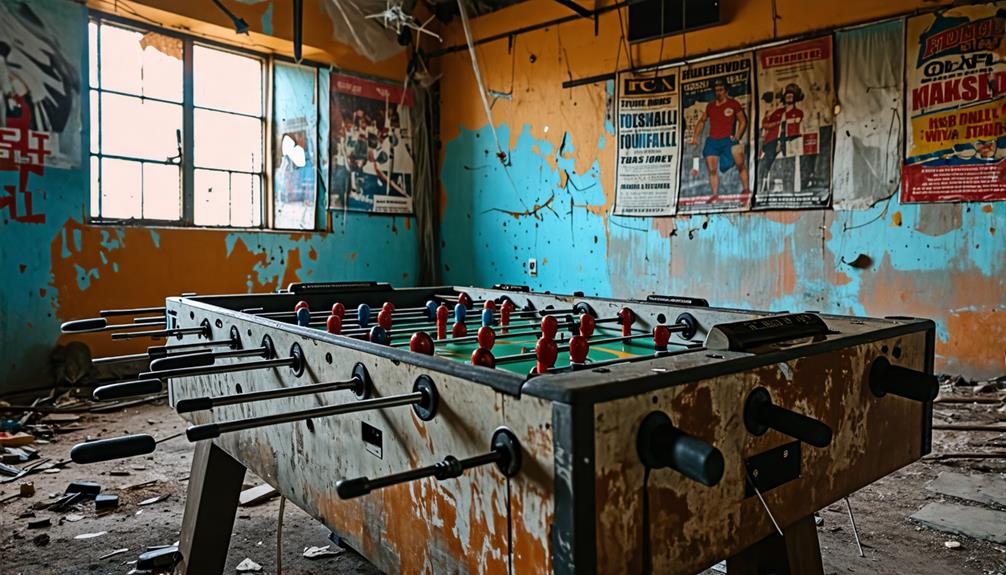
During the 1980s, foosball experienced a significant decline in popularity, primarily due to the emergence of arcade games such as Pac-Man. Monthly table sales dropped sharply from around 1,000 to just 100 by 1981, indicating a major shift in entertainment preferences. The competitive scene also faced hardships, with the International Tournament Soccer Championships declaring bankruptcy that same year, underscoring the financial difficulties within the sport.
While tournament culture had peaked in the late 1970s, offering substantial cash prizes, this success didn't extend into the subsequent decades. Notably, the amateur status of foosball in the UK resulted in lower prize money for competitions compared to those in the U.S., highlighting financial disparities within the sport.
Despite these setbacks, the establishment of the International Table Soccer Federation (ITSF) in 2003 provided a glimmer of hope. The ITSF aimed to revitalize foosball by regulating international competitions and fostering renewed interest. However, the challenges and decline during the 1980s had a lasting impact, necessitating considerable effort to rebuild its status in the gaming community.
Future of Foosball
While the challenges of the past have shaped foosball's landscape, the future looks promising with growing global interest and groundbreaking developments in the sport. The International Table Soccer Federation (ITSF) is actively promoting foosball, and several exciting changes are on the horizon:
- Increased Participation: Local leagues are flourishing, leading to more players engaging in competitive play and fostering a vibrant foosball community.
- Technological Advancements: Innovations such as robotic foosball players and automated tables are enhancing gameplay and providing new training methods to improve skills.
- Olympic Recognition: Efforts to gain Olympic recognition are ongoing, which would significantly elevate the sport's global visibility and attract more enthusiasts.
These developments signal a dynamic future for foosball, bridging the gap between recreational play and serious competition. By connecting with local clubs, embracing these advancements, and engaging with the ITSF, you can contribute to the sport's growth and experience the excitement of a revitalized foosball community. Participating in tournaments and supporting these initiatives will help shape the future of foosball for generations to come.
Conclusion
Foosball has evolved from its modest origins into a dynamic sport with a passionate community. Its development, cultural significance, and competitive landscape have all played a role in shaping its unique identity. Although challenges remain, the enthusiasm for the game persists, making it accessible and appealing to players of all skill levels. As the sport continues to grow, each match adds to its rich history and ongoing narrative.

